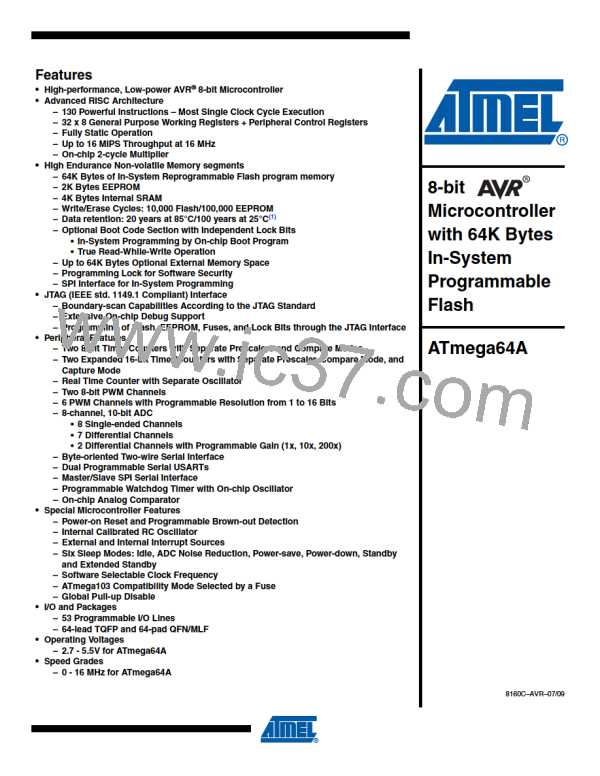ATmega64A
The function simply waits for the transmit buffer to be empty by checking the UDREn flag, before
loading it with new data to be transmitted. If the Data Register Empty Interrupt is utilized, the
interrupt routine writes the data into the buffer.
20.6.2
Sending Frames with 9 Data Bits
If 9-bit characters are used (UCSZn = 7), the ninth bit must be written to the TXB8n bit in
UCSRnB before the low byte of the character is written to UDRn. The following code examples
show a transmit function that handles 9-bit characters. For the assembly code, the data to be
sent is assumed to be stored in registers r17:r16.
Assembly Code Example(1)
USART_Transmit:
; Wait for empty transmit buffer
sbis UCSRnA,UDREn
rjmp USART_Transmit
; Copy ninth bit from r17 to TXB8
cbi
UCSRnB,TXB8n
sbrc r17,0
sbi
UCSRnB,TXB8n
; Put LSB data (r16) into buffer, sends the data
out
ret
UDRn,r16
C Code Example(1)
void USART_Transmit( unsigned int data )
{
/* Wait for empty transmit buffer */
while ( !( UCSRnA & (1<<UDREn)) )
;
/* Copy ninth bit to TXB8 */
UCSRnB &= ~(1<<TXB8n);
if ( data & 0x0100 )
UCSRnB |= (1<<TXB8n);
/* Put data into buffer, sends the data */
UDRn = data;
}
Note:
1. These transmit functions are written to be general functions. They can be optimized if the con-
tents of the UCSRnB is static. For example, only the TXB8n bit of the UCSRnB Register is
used after initialization.
For I/O Registers located in extended I/O map, “IN”, “OUT”, “SBIS”, “SBIC”, “CBI”, and “SBI”
instructions must be replaced with instructions that allow access to extended I/O. Typically
“LDS” and “STS” combined with “SBRS”, “SBRC”, “SBR”, and “CBR”.
The ninth bit can be used for indicating an address frame when using Multi-processor Communi-
cation mode or for other protocol handling as for example synchronization.
20.6.3
Transmitter Flags and Interrupts
The USART Transmitter has two flags that indicate its state: USART Data Register Empty
(UDREn) and Transmit Complete (TXCn). Both flags can be used for generating interrupts.
182
8160C–AVR–07/09

 ATMEL [ ATMEL ]
ATMEL [ ATMEL ]